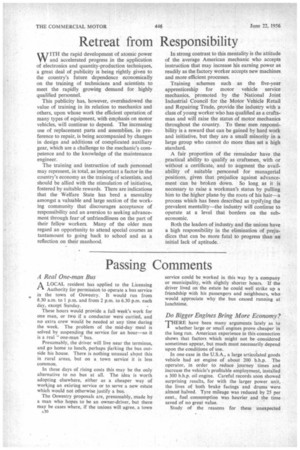Passing Comments
Page 32

Page 33

If you've noticed an error in this article please click here to report it so we can fix it.
A Real One-man Bus
A LOCAL resident has applied to the Licensing " Authority for permissiou to operate a bus service
in the town of Oswestry. It would run from •
8.30 a.m. to 1 p.m. and from 2 p.m. to 6.30 p.m. each
day, except Sunday.
These hours would provide a full week's work for one man, or two if a conductor were carried, and no extra crew would be needed at any time during the week. The problem of the mid-day meal is solved by suspending the service for an hour—so it is a real " one-man " bus.
Presumably, the driver will live near the terminus, and go home to lunch, perhaps liarking the bus outside his house. There is nothing unusual about this in rural areas, but on a town service it is less Common.
In these days of rising costs this may be the only alternative to no bus at all. The idea is worth adopting elsewhere, either as a cheaper way of working an existing service or to serve a new estate which would not otherwise justify a bus.
The Oswestry proposals are, presumably, made by a man who hopes to be an owner-driver, but there may be cases where, if the unions will agree, a town service could be worked in this way by a company or municipality, with slightly shorter hours. If the driver lived on the estate he could well strike up a friendship with his passengers and neighbours, who would appreciate why the bus ceased running at lunchtime.
Do Bigger Engines Bring More Economy?
THERE have been many arguments lately as to I whether large or small engines prove cheaper in the long run. American experience in this connection shows that factors which might not be considered sometimes appear, but much must necessarily depend upon the conditions of use.
In one case in the U.S.A., a large articulated goods vehicle had an' engine of about 200 b.h.p. The operator, in order to reduce journey times and increase the vehicle's profitable employment, installed a 300 b.h.p. oil engine. Careful records soon showed surprising results, for with the larger power unit, the lives of both brake facings and drums were almost halved. Tyre mileage was reduced by 25 per cent., fuel consumption was heavier and the time saved of no great value.
Study of the reasons for these unexpected
happenings showed that the effects, occurred almost entirely while the vehicle was travelling uphill. On the level, the cruising speed was determined by a combination of road conditions and traffic density, no matter whether the small or large engine was used.
On down gradients, the controllable speed was chosen by the driver with no thought of engine output; when climbing, however, almost full advantage was taken of the higher power, with a considerable increase in fuel consumption. The higher speed involved use of the brakes when cornering and negotiating the traffic, whilst there was loss of wheel grip which did not occur when climbing steadily but more slowly with the original size of engine.
A similar condition of affairs seemed to be • experienced with new cars of high power; again, any improvement being more than offset by the disadvantages_
Prepared to Aid Production
A N interesting and certainly up-to-date service in 4-5the commercial-vehicle field is being offered by Messrs. Rippon Bros., Victory Works, Woodend
• Avenue, Speke, Liverpool, 19. They claim to be able to produce designs for vehicles, other than prime movers, ranging in carrying capacity from 3 cwt. to 300 tons, for specialized transport, oil-field equipment and the Services. They advise on design for flow-line production and produce scale models for prior discussion. Normaland high-speed cinematography is employed for a system of photo-analyzing. This permits breaking down labour and machine-tool operations with the idea of reducing unproductive time and of arriving at an advised degree of automation, also the best layout of equipment.
These are big claims and it will be interesting to learn how they are being substantiated and whether these automation consultants can compete successfully with the technicians already employed by many producers.
Meet Mr. Busman
ASIMPLE yet effective method of developing the personal touch between coach crews and their passengers was noted by delegates to the Institute of Transport Congress at Southport when they travelled in some of the newest vehicles operated by Ribble Motor Services, Ltd. On the front bulkhead, facing the gangway, was a boldly lettered but neat plastic panel bearing the words: Introducing Driver
Conductor Slides of matching material, each bearing the name of a member of the staff, enable the appropriate information for each journey to be fitted into the name panels.




































































































